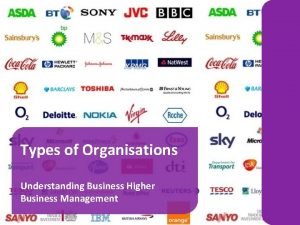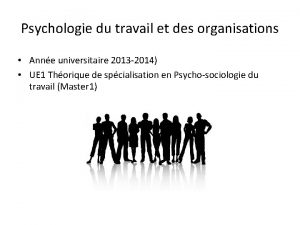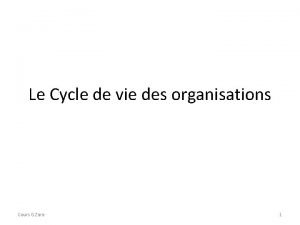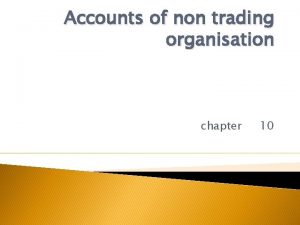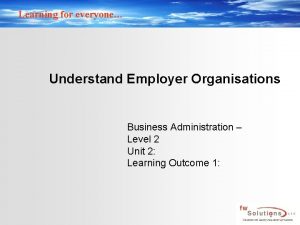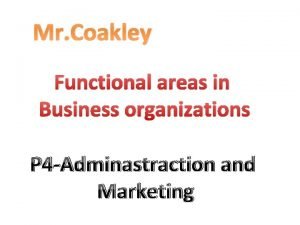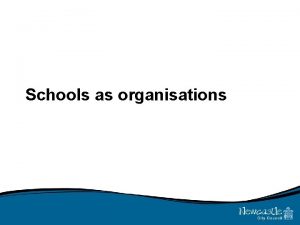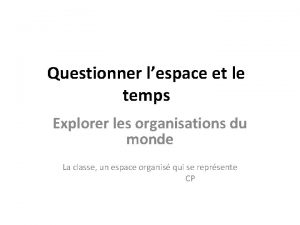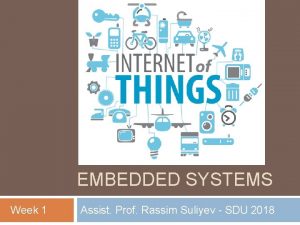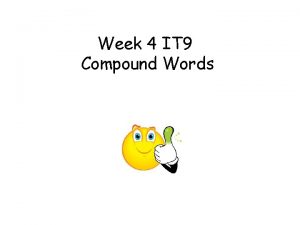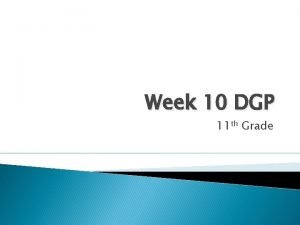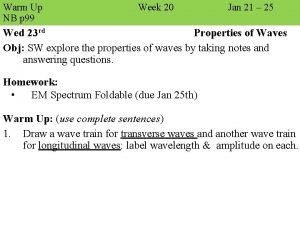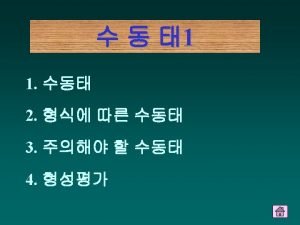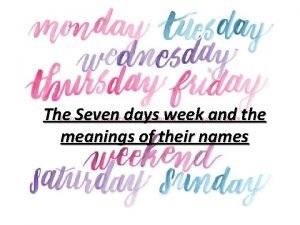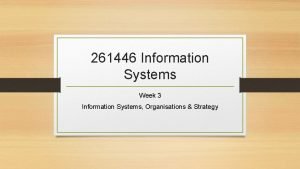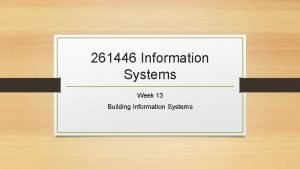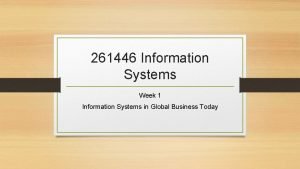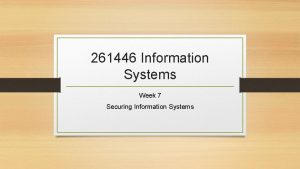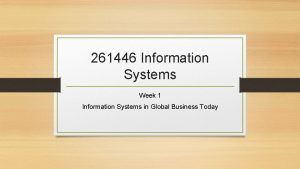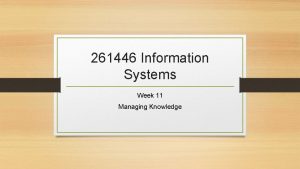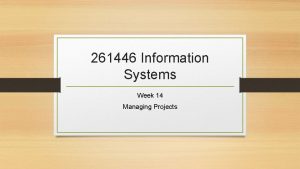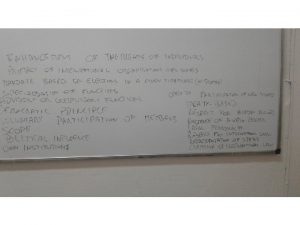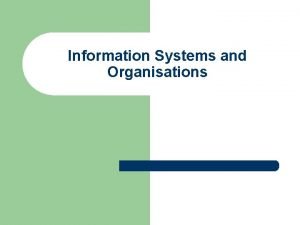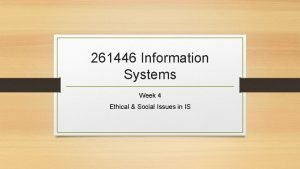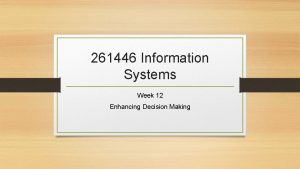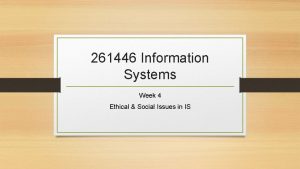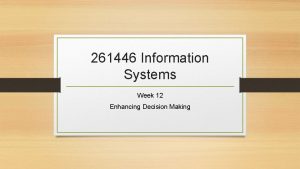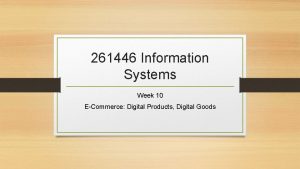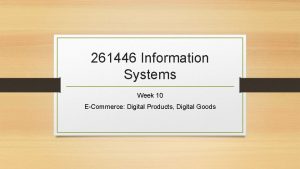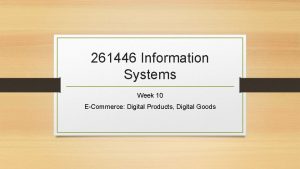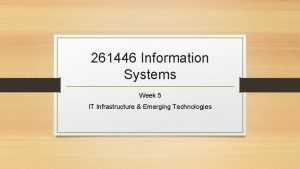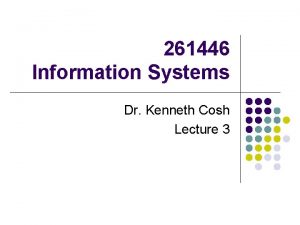261446 Information Systems Week 3 Information Systems Organisations






































- Slides: 38

261446 Information Systems Week 3 Information Systems, Organisations & Strategy

Week 3 Topics • • Impact of IS on organisations Porter’s 5 Forces Analysis, for developing competitive strategies Value Chain for strategic analysis Core Competencies, Synergies & Networked strategies

Case Studies • #1) Sears • #2) Barnes & Noble

Organisations & Information Systems • IS & Organisations have an intricate relationship, with complex interactions. • New IS can change social and worklife, so it important to understand the impacts of / on; • Organisation Structure • Business Processes • Politics • Culture • Surrounding Environment • Management Decisions

Mediating Factors

Organisation • “A stable, formal social structure that takes resources from the environment and processes them to produce outputs. ” • Key resources are capital and labour • It is formal, not like a casual group of friends meeting for lunch, which means they are legal entities with internal rules & procedures which must abide by the law. • They are also social structures, with people & relationships, not just a machine.

Organisations – Behavioural View • As well as the formal rules, over time the people in the organization develop their custom ways of working; • Develop certain relationships • Make arrangements with superiors & subordinates about what work will be done, how much, when, under what conditions etc.

Behavioural View • Considering the formal definition of an organization, implementing new IS simply involves substituting one structure & processes with another. • Considering the behavioural view, implementing a new IS is more complex, • Changing elements can take a long time, and be disruptive • A Socio-Technical perspective, not just a Technical one.

Organisational Features • Organisations are bureaucratically organized, with clear divisions of labour & specialisations • Hierarchy of Authority • Actions governed by rules & procedures • Hiring & promoting based on qualifications • Efficiency: Maximising output using limited input

Organisational Features: Business Processes • Organisations become more efficient over time by developing routines, or standard operating procedures, to deal with all expected situations. • Employees become more productive as they learn the routines. • A business process is a collection of these routines.

Organisational Features: Politics • “Because I said so!” • Organisations are comprised of different people with different specialities, concerns, perspectives; and so differing viewpoints. • On, how resources, rewards & punishments are distributed. • As resources are not infinite, this leads to political struggles & conflict • Political resistance is a key barrier to organizational change • such as implementing a new system

Organisational Features: Culture • “It’s how we do it!” • A set of unassailable, unquestioned assumptions that define goals & products. • Taken for granted, and rarely discussed • Culture unifies people, and restrains political conflict, promoting common understandings & practices • Culture is also a big restraint on change; • Technological changes that threaten cultural assumptions will be stalled and face resistance.

Organisational Features: Environment • Organisations exist within an environment • From which they get resources, and give goods & services • Organisations & their environment have a close relationship • Organisations can not exist without their environment, must obey the rules of the environment, but can also influence it (perhaps through marketing) • Environments change, often faster than organisations • New technologies, new products, changing public tastes, values and fashions • Organisations resistant change due to culture, politics & people

Disruptive Technologies • Substitute products the perform better than anything currently produced • Which can put entire industries out of business • E. g. the car replacing carriages, word processor replacing typewriters, digital photography • Companies that can ‘ride the wave’, can have massive success by being a “first mover” • E. g. Google’s Page. Rank algorithm

Organisational Features: Structure • Entrepreneurial Structure • Young, small firm in fast-changing environment, managed by single CEO • Machine Bureaucracy • Large bureaucracy in slow moving environment, dominated by centralized decision making • Divisionalised Bureaucracy • Combination of Machine Bureaucracies producing different products, managed by central headquarters • Professional Bureaucracy • Knowledge-based organization, depending on expertise of professionals. Departmentalised • Adhocracy • Task-force, with groups of specialists organized into short-lived multidisciplinary teams

IS for Competitive Advantage • Firms that “do better” than others have some competitive advantage • E. g. Google for Search, Amazon for Online sales, Walmart for Offline sales • Often IS can be applied to gain a competitive (or strategic) advantage.

SWOT Analysis • • Strengths Weaknesses Opportunities Threats

Porter’s 5 Forces Threat of New Entries Bargaining Power of Suppliers Intensity of Rivalry Threat of Substitutes Bargaining Power of Buyers

Bargaining Power of Customers • • • Buyer concentration vs Firm Concentration Buyer Volume Buyer switching costs Ability to backward integrate Price Sensitivity Product Differences Brand Identity Impact of quality / performance Buyer Profits

Bargaining Power of Suppliers • • Differentiation of Inputs Switching costs of suppliers Supplier Concentration Ability to forward integrate

Threat of Substitutes • Impact on Supplier & Buyer Power

Threat of New Entries • • Economies of Scale Brand Identity Switching costs Capital Requirements Access to Distribution Cost Advantages Government Policy Expected Retaliation

Intensity of Rivalry • • • Industry Growth Product Differences Brand Identity Switching Costs Diversity of Competitors Exit Barriers

Determine a Strategy • • Low-Cost Leadership Product Differentiation Focus on Market Niche Strengthen Customer & Supplier Intimacy

Low Cost Leadership • Become the low-cost producer of products, by finding ways to lower our costs, lower our customers and suppliers costs or increase our competitors costs. • IT can drive cost reduction, such as reducing labour costs. • SCM systems can assist reducing suppliers costs (Walmart). • Online Price adjustment, to match best match competitors prices.

Product Differentiation • Develop ways to make our product different from our competitors (or reduce our competitors differentiation). • IT can assist by introducing IT features to a product such as a camera on a phone. • Reduce competitors by integrating their differentiated ideas (adding a camera to our phone too!) • Google is constantly adding features, such as google maps

Focus on Market Niche • Use IS to satisfy a particular market segment better than competitors. • Collect data about your target niche, analyse that data to finely tune the product, service, sales, marketing etc. • Hilton Hotels’ On. Q system provides detailed analysis of all it’s customers to maximize the profitability of each guest.

Strengthen Customer & Supplier Intimacy • Build better relationships with customers, such as with CRM, increasing loyalty. • Develop switching costs • Amazon “Hi Ken, how about your wishlist. . . ”

The Traditional Value Chain Core Operating Activities Inbound Logistics Operations Outbound Logistics Marketing & Sales Support Activities Human Resource Management, Infrastructure, Information Technology Services

The Value Chain Information Data Core Operating Activities R&D Information Knowledge Procurement Production Marketing & Sales Infrastructure Facilities & Equipment Technology People After Sales Services

Adding Value • Companies make their profits by adding value at some stage in the value chain. • Gaining Economies of Scale • Gaining Economies of Scope

Economies of Scale • Occur when mass producing a product, a lower average cost is attained. • Technical • Managerial • Financial • Marketing • Commercial • R&D

Network Economies of Scale • A “Community” of firms share infrastructure, capabilities, customer base etc. to produce and distribute products faster and cheaper etc.

Economies of Scope • The average total cost of production decreases as a result of increasing the number of different goods produced. • For Example, Mc. Donalds can produce Hamburgers & Fries cheaper than other companies could produce either individually.

Network Economies of Scope • The “Community” shares infrastructure to produce and distribute new products and services, enter new markets etc. quicker and cheaper etc.

Synergies • Synergies occur when two or more organisations combine to gain some shared benefits • With modern Communication Technologies the opportunity for synergies increases

Core Competencies • A core competency is an activity at which the organisation is a leader. • Within a networked economy organisations are able to focus on these core competencies, and find synergies with organisations that have complementary core competencies.

Managing Competitive Advantage • Strategic Information Systems, do not always last long enough for long term profitability • Copy-cat systems emerge as competitors seek to reduce your competitive advantage • A first mover may gain an advantage, but successful organisations need to constantly analyse their environment and keep adapting to maintain competitive advantage.
 Week by week plans for documenting children's development
Week by week plans for documenting children's development Contemporary organisations
Contemporary organisations Understanding business management
Understanding business management Rms ema
Rms ema How humans behave in organisations
How humans behave in organisations Psychologie du travail et des organisations dolan
Psychologie du travail et des organisations dolan Cycle de vie des organisations
Cycle de vie des organisations Accounting for non trading organisation
Accounting for non trading organisation Find an end point assessment organisation
Find an end point assessment organisation Understand employer organisations
Understand employer organisations Functional areas in business organisations
Functional areas in business organisations Communication socionumérique des organisations
Communication socionumérique des organisations Psychosociologie des organisations
Psychosociologie des organisations Schools as organisations
Schools as organisations Explorer les organisations du monde
Explorer les organisations du monde Koroui
Koroui Decision support systems and intelligent systems
Decision support systems and intelligent systems Engineering elegant systems: theory of systems engineering
Engineering elegant systems: theory of systems engineering Embedded systems vs cyber physical systems
Embedded systems vs cyber physical systems Engineering elegant systems: theory of systems engineering
Engineering elegant systems: theory of systems engineering Htcondor week
Htcondor week Htcondor vs slurm
Htcondor vs slurm Ana ascenção e silva
Ana ascenção e silva Week 9 dgp
Week 9 dgp Dgp week 8 answers
Dgp week 8 answers Arm compound words
Arm compound words Week 16 dgp
Week 16 dgp Dgp week 12
Dgp week 12 Dgp week 11
Dgp week 11 Dgp week 20 answers
Dgp week 20 answers Tv turn off week
Tv turn off week Remeber asl
Remeber asl How did you ... your last weekend
How did you ... your last weekend What __________ you _________ last weekend?
What __________ you _________ last weekend? Kanji days of week
Kanji days of week Who broke this window
Who broke this window Frīgedæg
Frīgedæg Omer meroz
Omer meroz Surgical education week
Surgical education week


